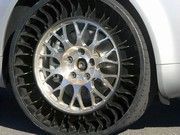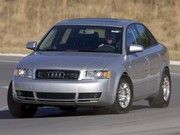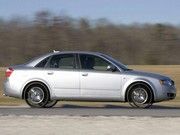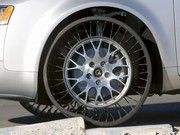Michelin rolls out airless tyre
Tweel offers vision of maintenance-free tyres
Michelin wheeled out its airless tyre at the North American Motor Show yesterday, describing it this time as "the first real-world fitment" (see link below for earlier story). And it might coming to a car near you soon.
Michelin's Tweel is in production and available as an enhancement for future iBOT mobility systems for the disabled. Invented by Dean Kamen, the iBOT mobility device can climb stairs and navigate uneven terrain, offering mobility freedom impossible with traditional wheelchairs.
Beyond these first real-world applications, Michelin said it has additional projects for Tweel on construction skidsteers and a variety of military vehicles.
The most intriguing application may be Michelin's early prototype Tweel fitment for passenger cars. The mobility company released a video of Tweel running under an Audi A4.
"The Tweel automotive application, as demonstrated on the Audi, is definitely a concept, a stretch application with strong future potential," said Michelin's research boss Terry Gettys. "Our concentration is to enter the market with lower-speed, lower-weight Tweel applications. What we learn from our early successes will be applied to Tweel fitments for passenger cars and beyond."
What is a Tweel?
The heart of Tweel innovation is its simple-looking hub and spoke design that replaces the need for air pressure while delivering performance that Michelin claimed is akin to that of pneumatic tyres. The flexible spokes are fused with a flexible wheel that deforms to absorb shock and rebound easily. Without the air needed by conventional tyres, Tweel still delivers pneumatic-like performance in weight-carrying capacity, ride comfort, and the ability to envelop road hazards, reckoned the company.
Michelin said it had found that it can tune Tweel performances independently of each other, which is a significant change from conventional tyres. This means that vertical stiffness (which primarily affects ride comfort) and lateral stiffness (which affects handling and cornering) can both be optimised, improving performance and enabling new performances not possible for current inflated tires.
The Tweel prototype, demonstrated on the Audi A4, is within five per cent of the rolling resistance and mass levels of standard tyres so fuel economy should be almost unaffected, said Michelin. Michelin said it had increased the lateral stiffness by a factor of five, making the prototype unusually responsive in its handling.
Future of Tweel technology
For Michelin, Tweel is a long-term vision that represents the next step in a long path of industry-changing innovations. The lessons learned from Tweel research are being applied to improve conventional tyre performances, according to Michelin. In the future, Tweel may reinvent the way that vehicles move. Tyre maintenance and balancing between traction and comfort could all fade into memory, said the company.
Gassing Station | General Gassing | Top of Page | What's New | My Stuff







